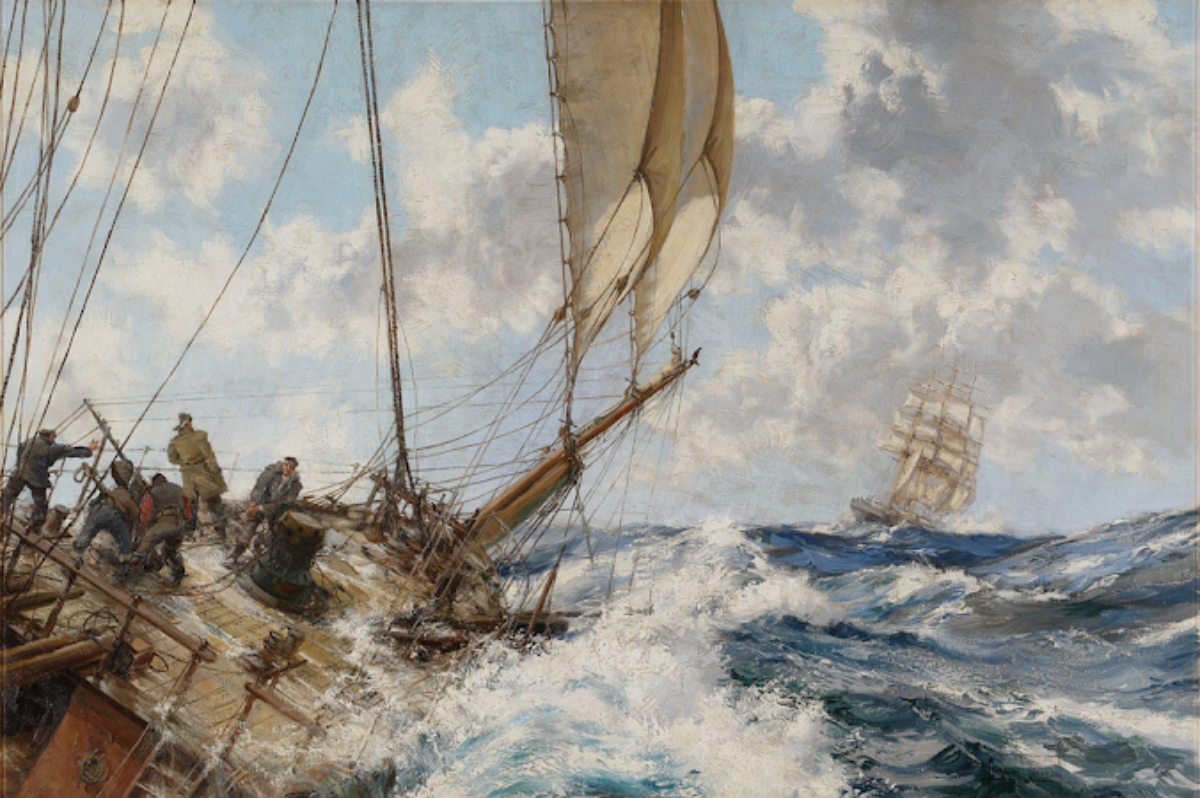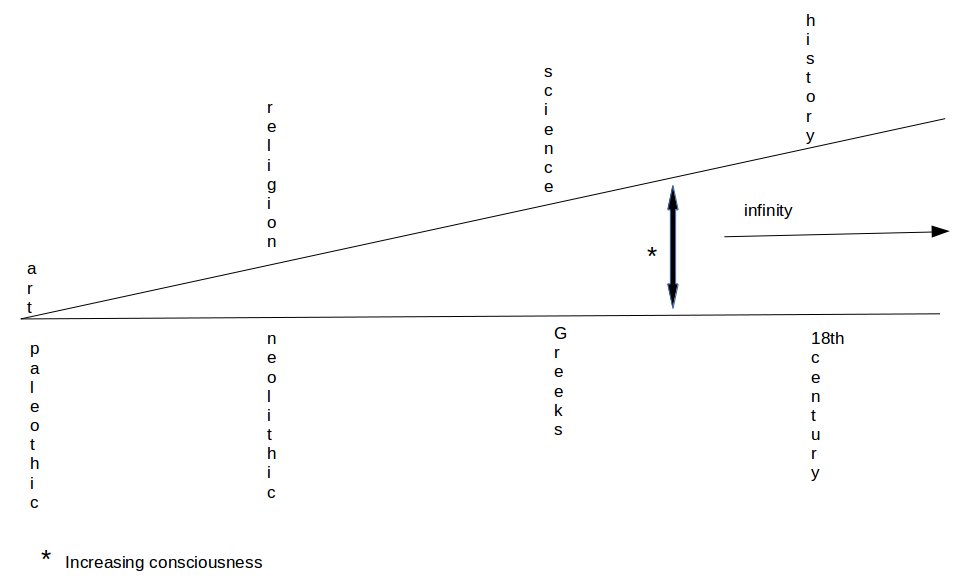M. de Rougemont intends with his analysis of the literature surrounding the Tristan and Isolde myth, its development through the centuries, to diagnose the breakdown of western civilisation, especially marriage. While he believes he succeeds he stops short of prescribing a solution thinking instead it would likely do more harm than good. He adopts the attitude that its best to just let it play out hoping along the way we don’t destroy ourselves in the process. For, indeed, the morphology of the myth in its final stages invests our predatory nature with fantastic war making abilities augmented, it seems, with ever increasing machine, and now computerized, and it would seem biological, methods of killing vast numbers of people, whole populations, or segments thereof.
Though he makes no prescription for the culture as a whole he does embrace Soren Kierkegaard’s views on coping with the madness.
Cite SK. Pg 315: Adopts Kierkegaard’s view as his own that human life tends to proceed in stages from the aesthetic through the ethical, ending in faith. Passion, he thinks, is “the highest value in the aesthetic stage” while extolling marriage as the highest in the ethical. But marriage is claimed to be the highest obstruction in the religious stage for it fetters one to time whereas faith requires eternity.
In this writer’s view the image of the sword placed between Tristan and Iseult as they sleep signifies what is said about renouncing marriage as an obstruction when entering life’s final stage of faith. “Goal was no longer redemption through love but redemption through renunciation.” One gives up passion, love, in favor of dissolving the little self with the eternal. This is why Tristan can say I am the whole world as Wagner has him do.
Doesn’t this correspond nicely with Kierkegaard’s attitude? Rougemont writes: “When the lover in the Manichaean legend has undergone the great ordeals of initiation he is met … by a dazzling maiden who welcomes him with the words: ‘I am thyself!’ So with fidelity in the myth, and Tristan’s. Fidelity is then a mystic narcissism … imagining itself to be true love for the other. In analysing the courtly legends, however, we saw that Tristan is not in love with Iseult, but with love itself, and beyond love he is really in love with death – that is, with the only possible release there can be for a self guilty and enslaved. Tristan is true neither to a pledge nor to a symbolical being named Iseult. She is but a lovely pretext, and all the time he is being true to his most profound and secret passion. The myth seizes on ‘the death instinct’ inseparable from any form of created life, and transfigures it by bestowing upon it an essentially spiritual goal. To destroy oneself, to despise happiness is thereupon a way of salvation and of acceding to a higher life, to ‘the highest bliss of being’ sung of by the expiring Isolde (in Wagner’s opera).” Life for the sake of death was Tristan’s passion and “The love of Tristan and Iseult was the anguish of being two; and its culmination was a headlong fall into the limitless bosom of Night….Iseult is no more, Tristan no more, and no name can any longer part us!”
Kierkegaard’s existential anguish, his fear and trembling (Frygt og Baevan) resulting from the lost love of his Regine brought him low and he ended as a “fatally unhappy” man which he equates with man’s relation with an eternal and holy God from the standpoint of the finite and sinful human. He said “God creates everything ex nihilo.” Whomsoever God elects by his love, “He begins by reducing to nothing.” This, he said, makes God “my mortal enemy.” M. de Rougement writes: “Here we are being brought up against the extreme limit, the pure springs of passion; and in the same moment we are thrust into the heart of the Christian faith! For, behold! the man now dead to the world, killed by infinite love, has to go forward and to live in the world….(such a man) has renounced all things with an infinite resignation, and …. is constantly leaping into the infinite, but faultlessly and with complete confidence, so that he drops back into the finite, and nothing is noticeable about him but the finite.”
Finally, Rougemont continues: “Thus the extremity of passion – death in love -introduces a new life, where passion never ceases to be present, but is under the most jealous incognito; for it is now far more than regal, it is divine.” (This is in contradiction to his former exegesis of the myth, in this writer’s opinion, but is in reality much nearer the actual Truth. While all that goes before goads the reader into plumbing the myth’s and western civilization’s morbidity his final summation and recap is rather uplifting, offers some hope.)
This makes sense, I think, of Tristan’s “I am the world” attitude. Whereas mystic union, the explanation thereof, fails completely one can nevertheless circumscribe it, though perhaps only in increasingly vague terms. While it admittedly is a slippery matter perhaps one learns that though it evades our attempts to grasp or hold it we can gain somewhat by just accepting it (with cupped hands, so to speak). Receive instead of take, in other words. Denis de Rougemont is a master of all this, as was Soren Kierkegaard, and for that matter Socrates, Jesus, the Buddha – its a long list. Suffice to say, Rougemont continues: “We are unendingly and incessantly in the thick of the struggle between nature and grace; unendingly and incessantly unhappy and then happy. But the horizon has not remained the same. A fidelity maintained in the name of what does not change as we change will gradually disclose some of its mystery: beyond tragedy another happiness waits. A happiness resembling the old, but no longer belonging to the form of the world, for this new happiness transforms the world.
As said elsewhere Beauty is infinite, eternal, ever increasing, ever glorifying the divine. To get a little taste of this is man’s lot gained by living in the finite, as intended, but from an eternal perspective. And, quoting Mr. T.S. Eliot, “when arriving at our destination we see it as our beginning but know it for the first time.”
Infinite resignation is like total surrender to God……only then can we live perfectly in imperfection. Also said elsewhere in this blog, though its in error to ascribe to G_d anything at all, not even being itself (after all, Soren Kierkegaard himself, and he was and is known as a Christian philosopher, actually stood in the pulpit and expounding on faith, said that God does not exist. Why? Simplicity itself – “He is eternal” – that’s why. That should need no explanation. And yet, in Exodus, appearing in a burning bush before Moses, asked “who shall I say sent me?”, he replies, ” Say that ‘I am’ sends you.”) it nevertheless dips into the limitless vastness of Beauty and Love and Truth to say that we sentient life forms, human beings on planet Earth, are the eyes and ears of the Cosmos, that simple device whereby G_d, if you like, has, or gains self realization, self understanding. The horizon of discovery is thus ever and anon pushed into infinity with we humans in endless renewal making pursuit. At the very least, I think, we are of the same stuff as the Sun, so our perception is no doubt the Sun’s way of knowing itself. As stated this can not be explained for it is a matter of direct knowledge, Noesis, from which derives the noosphere wherein we find the concomitants of consciousness.

